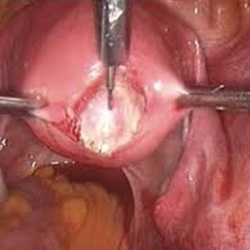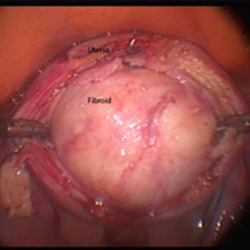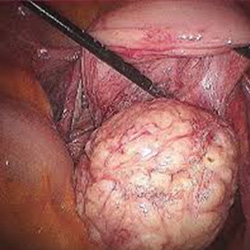Laparoscopic Myomectomy and Abdominal Myomectomy
What is a laparoscopic myomectomy?
The laparoscopic myomectomy procedure was developed to provide a minimally invasive technique to the abdominal myomectomy. The laparoscopic myomectomy typically requires a minimum of three incisions (one in the umbilicus and two lateral to the umbilicus). The goal is to remove the fibroids while preserving the uterus, the fallopian tubes and ovaries.
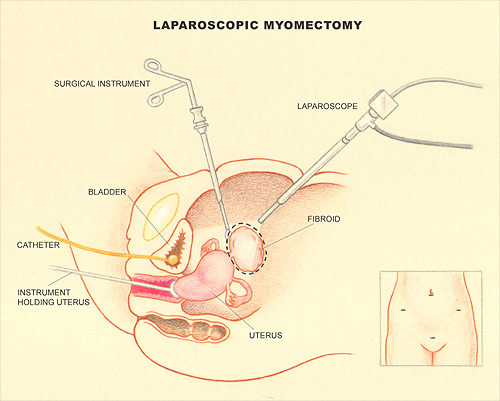
How do fibroids develop and how fast do the fibroids grow?
The uterus is made up of millions of SMOOTH MUSCLE CELLS that are uniform and grow together in sync. However, if you have THREE fibroids (aka myomas), that mean that you have three individual muscle cells that decided to grow independently and “go rogue” from the rest of the cells. Sometimes, the fibroid(s) grow slowly, and other times, the fibroids grow fast. There is both a genetic association and an ethnic association with fibroids. The fibroid(s) are stimulated by estrogen, so the fibroids may continue to grow until menopause. The first step in the rate of growth of fibroids is to perform serial pelvic ultrasounds, approximately once every year.
What are the FIVE different types of fibroids?
Fibroids are classified by the location of the fibroid(s) within the uterine wall.
a. PEDUNCULATED FIBROID grows on a STALK on the outer surface of the uterine wall. These are the easiest fibroids to remove laparoscopically. (See image below)
b. SUBERSEROSAL FIBROID is located on outer surface of the uterine wall.
c. INTRAMURAL FIBROID is located in the muscle of the uterine wall.
d. SUBMUCOSAL FIBROID is located part IN the uterine cavity and part IN the uterine wall.
e. TRANSMURAL FIBROID grows the full thickness of the uterine wall (which is a combination of a subserosal fibroid, intramural fibroid, and submucosal fibroid).
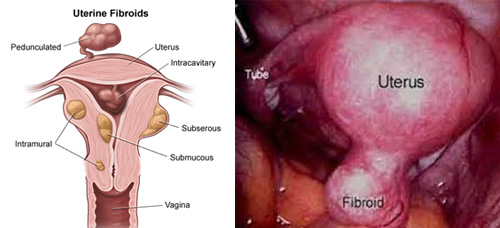
SURGICAL perspective of a laparoscopic myomectomy of 1 single fibroid.
This is removal of one TRANSMURAL fibroid. This TRANSMURAL fibroid contains a subserosal component and an intramural component and a submucosal component.
For any type of fibroid that grows full thickness of the uterine muscle wall, ALL patient that get pregnant in the future will require Cesarean section for delivery. You cannot undergo vaginal delivery because the site of the uterine incision will ALWAYS be weaker and there would be a higher risk of uterine rupture at the myomectomy incision site during the labor process.
What are the limitations of the laparoscopic myomectomy?
a. If there are 4 of less fibroids, the laparoscopic myomectomy should be a feasible approach.
b. If there are 8 or more fibroids, I would recommend an abdominal myomectomy. If there is between 4-8 fibroids, then it is a judgment call intraoperatively.
c. If the total uterine size (including the fibroid(s)) is less than 16 cm, then a laparoscopic myomectomy is feasible. If the total uterine size is 18 cm or larger, I would recommend an abdominal myomectomy.
d. If the fibroid(s) are in a “BAD LOCATION” such as obstructing the fallopian tubes or located in the posterior lower uterine segment of the uterus, I would recommend an abdominal myomectomy.
e. OVERALL, the most important TWO factor area (a) safety of the procedure and (b) preservation of the uterus, fallopian tubes, and ovaries.
ABDOMINAL MYOMECTOMY PROCEDURE:
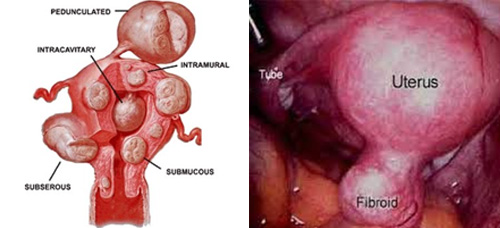
What are the INDICATIONS for an abdominal myomectomy?
If the uterus is too big (18 cm or greater) or if there are too many fibroids (x > 8 fibroids) or if the fibroid(s) is in a “BAD LOCATION” (distorting the fallopian tubes or at the posterior lower uterine segment), then the safer approach is an abdominal myomectomy.
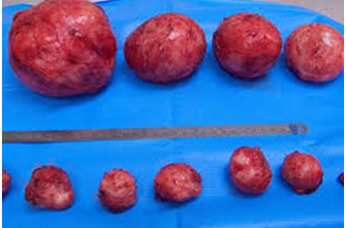
Typically, a Pfannenstiel incision (aka Cesarean incision) is made. The size of the incision will be dependent upon the size of the fibroids. The larger the fibroid(s), the larger the incision.
